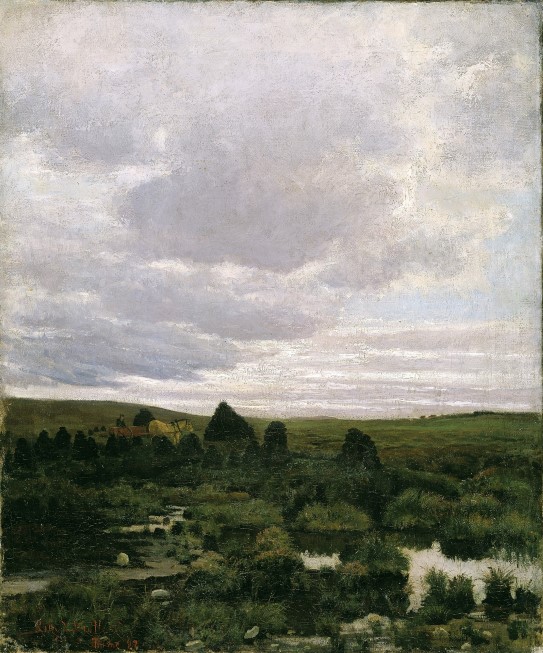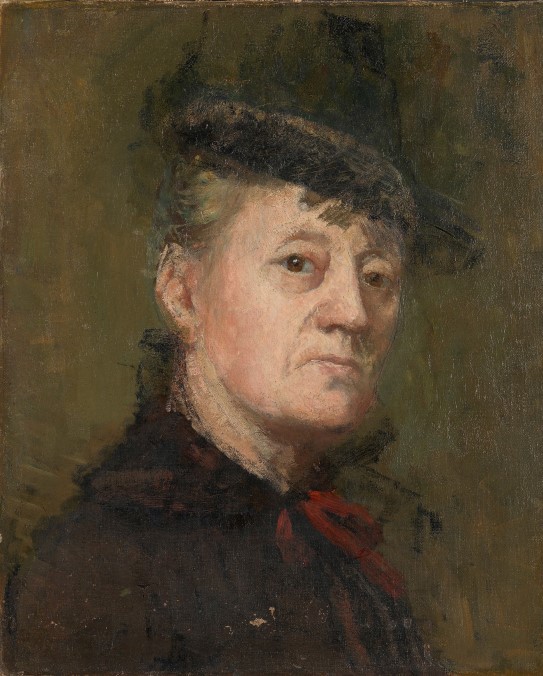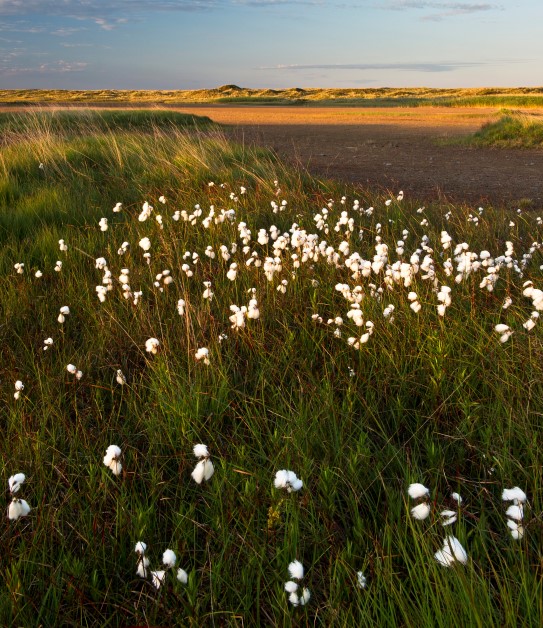Text by Senior Communications Advisor Ellisiv Brattfjord
She fell in love with the bog landscape without even being aware of the bog's unique value as a carbon store, flood absorber and home to many endangered species; things we have since come to appreciate.
Kitty Kielland wrote in a letter to her artist friend Eilif Peterssen in the summer of 1878: "It is a miserable struggle with the fierce wind, which drives sand into your head through your eyes and ears, mixes into all your paints on the palette and finally covers the whole study. I get so annoyed that I quarrel with all my might. The wind answers with clouds of sand and violent gusts of wind". This makes sense; Kitty Kielland was an outdoors painter.
Kielland was the first Norwegian artist to capture the landscape in Jæren with a paintbrush. She was here almost every summer from the time she first discovered the picturesque potential of the barren nature. Kielland cast her gaze first over the beaches and the sea and created paintings such as Fra Kvianes på Ogna, Jæren (From Kvianes at Ogna, Jæren) (1878). She focused on the rocks, sand and sparse vegetation that grew between old stone fences. But then she discovered the peat bogs, which in the 19th century covered large parts of Jæren. They created a horizontal and treeless landscape, with vast skies, something the artist associated with a form of freedom, according to Inger M. L. Gudmundson, art historian and curator at Stavanger Art Museum, and currently completing Norway's first doctorate on Kitty Kielland.
"The peat bogs offered a diversity and an ambiguity that fascinated her. Here she could paint realistic scenes with farmers at work and neo-romantic mood paintings with skies, clouds and cotton-grass reflected in the bog pools. The tree roots that were dug out of the bog reminded her of the landscape's history and opportunities for change; it was unploughed land", says Gudmundson.

The valuable peat bog
Have you ever tried to cross a bog? You will most likely get your feet soaking wet. At first glance, bogs may not be what most of us would think of as a beautiful or inviting natural landscape. Many insects and birds, on the other hand, would disagree with this assessment, if we were able ask them directly.
In 2021, a bog might also be associated with environmental degradation caused by agriculture and development of holiday cabins, roads and wind farms.
"Many, if not most, of the bogs that Kitty Kielland painted have likely disappeared. Some were extracted as peat fuel, but most were ditched, drained and cultivated", says biologist and professor at the University of Oslo, Dag O. Hessen.
One consequence of this is that a great deal of the bog's biological diversity, such as birds, amphibians and insects, has been reduced.
The bog not only offers biological diversity, but also plays an important role in carbon binding.
"Many of the bogs are several metres deep and here the plant material does not decompose. The black bog soil consists mostly of carbon. When the bog is ditched and dried out, much of this will be oxidised to CO2", says Hessen.
The bog is the land-based natural habitat that binds the most carbon. Carbon equivalent to 250 000 tonnes of CO2 can be stored in one square kilometre of bog, according to the biodiversity organisation Sabima. So it is not surprising that biologists view bogs as Norway's equivalent of the rainforest.
The bogs are also excellent flood absorbers. "Peat moss can hold water equivalent to ten times its own weight. This means that bogs act like a natural sponge. They retain water during wet periods, and release water to the surrounding environment during dry periods. Due to climate change, we can expect more precipitation, but also more periods of drought in some parts of Norway. There has never been a greater need for more water-regulating nature than now", Sabima writes on sabima.no.
In the chapter Jæderen in the book Norge i det nittende aahundrede (Norway in the nineteenth century), Kielland describes how the landscape changed during her time.
"What one summer was a peat bog, the next was a heavily cultivated field. Both her texts and paintings, and those of others, provide us with important knowledge that we can benefit from, both today and in the future. At that time the peat bogs were replaced with agricultural land, now we see the value they have for ecosystems", says Gudmundson.
Peat bogs
- Bogs cover around 9.8 per cent of the land area of Norway and are a type of wetland.
- Peat is formed by moss, grass, leaves and other organic material remaining in water-rich areas for a long time. Due to lack of oxygen, the material does not decompose fully.
- Over the years, peat has been extracted for building materials, gardening and fuel, among other things.
- It takes nature several thousand years to make a peat bog. The bog grows only one millimetre a year, so a bog that is five metres deep is around 5000 years old.
- Norwegian bogs store at least 950 million tonnes of carbon. This corresponds to 66 years of Norway's annual greenhouse gas emissions.
- According reports from the Intergovernmental Platform on Biodiversity & Ecosystem Services, 85 per cent of the world's wetlands have disappeared.
- In Norway, one-third of the country's bogs have been removed in the last 70 years.
- According to figures from the Norwegian Institute of Bioeconomy Research (NIBIO), around 2600 decares of bog have been cultivated every year between 2007 and 2015 in Norway.
- With effect from 2 June 2020, the Norwegian government banned cultivation of bogs, but local municipalities still have the option of allowing cultivation when certain conditions are met.
The artist in the bog
The first painting Kitty Kielland painted of the peat bogs in Jæren, Un jour sombre en Norvège (A Dark Day in Norway), was exhibited at the prestigious Salon in Paris in 1880. The painting is considered a masterpiece of visual art.
"Here she has found the 'greatness and wealth of poverty' she wants to portray", writes Christian Krohg after interviewing Kielland for the book Kunstnere (The Artists) in 1891. For almost 30 years Kielland returned regularly to the peat bogs in Jæren and painted them in all kinds of weather.
According to Gudmundson, the peat bog paintings provide a unique insight into Kielland's development as a painter.
"The sky is always overwhelming, whether it contains drifting storm clouds or fluffy cumulus clouds. The earliest paintings are darker in colour and the bog ponds are depicted as small puddles. Gradually the colour palette becomes lighter, the still peat ponds larger, and by moving the horizon lower in the paintings, like a reflection, she adds a vertical touch to the horizontal landscape. Sky and land stand vertically against each other, while the landscape itself is vast. The poetic power is in my opinion the most special feature of the paintings".
Kielland adapted to the life of the local farmers in Jæren. She lived with local families and adapted, like the farmers, to the weather. The artist rarely let herself be stopped, according to Terjesen. "In cold and wind she goes to work, on one motif in the morning, and on another in the afternoon; she is in action from early morning until late at night".

Kitty Kielland
- Christine Lange Kielland (Kitty) was born in Stavanger on 8 October 1843.
- The Kiellands were an affluent family that had lived in Stavanger for several generations.
- Painting became more than a hobby for Kielland after a long illness where she had little else to do.
- In the 1870s she studied under Hans Gude in Karlsruhe in Germany and later under Eilif Peterssen and H. Baisch in Munich.
- She lived and studied in Paris for several years, together with Harriet Backer, among others.
- Kielland fought for women's right to participate fully in art and highlighted differences in the upbringing of boys and girls.
- She was involved in the founding of the Norwegian Association for Women's Rights in 1884.
- Kielland was one of the first Norwegian artists to paint what would become known as neo-romantic mood paintings.
- Kielland exhibited often during her lifetime and participated in all the most important Nordic and international exhibitions where Norwegian artists were represented.
- Before she died in 1914, she bequeathed a large sum to the National Gallery for the procurement of Norwegian art, on condition that the artwork "breaks with tradition and adds new elements to the development of art".
Unique nature
The peat bogs in Jæren are part of a wetland area covering over 34 000 decares, and include 23 bogs, lakes and shallow water areas. Several bird species feed here before migrating south and the area has an abundance of special plant species. Have you heard of cotton-grass, long-stalked yellow-sedge, alpine bulrush or early marsh orchid? They are all rare plants native to this area.
Both nationally and internationally endangered species live in the wetlands in Jæren, such as the southern marsh snipe, southern yellow wagtail, English yellow wagtail, smew and corn crake. These birds thrive in the bogs. Bird species that nest or rest in Jæren are there for a reason. This is the landscape for which they were created, and they cannot easily adapt to new habitats if the wetlands disappear. They feed on the insects here, which will also be depleted if these areas disappear. Pollinating insects such as bees and butterflies are also fans of the bog. The flora and fauna in the bogs need these insects. By the way, if the bogs disappear further north, we will also lose the coveted cloudberries, according to biologist Christian Steel in an interview with the Norwegian Broadcasting Corporation (4 July 2019).
The wetlands in Jæren are today protected under the Nature Diversity Act. In addition to the unique bird and plant life, there are also around 150 protected ancient monuments here, including several burial mounds.
The cultivation of bogs was banned in Norway in June 2020. Dispensation can be granted in cases where the landowner loses other productive land due to the loss of leasehold land or public works such as road construction, as reported in the local newspaper Nationen (2 June 2020). However, extensive development of holiday cabins is still permitted in several valuable bog areas. The bog is not safe from human encroachment now or in the future.
Dag O. Hessen says that one-third of Norway's bogs have been lost since the Second World War.
"And most of the loss is in low-lying agricultural areas such as Jæren".
He claims that the type of documentation which Kielland and several outdoor painters created is extremely important.
"It shows the landscape as it once was and what has been lost, and says much more than photos. And besides, photos seldom feature this type of nature, which in its time was considered worthless".


Woman, stay inside
Was Kitty Kielland aware of the ecological value of the bog? If so, it was probably not for the same reasons that we are concerned today.
In the second half of the 19th century, more and more women began to paint landscapes. More practical fashion (but still large skirts) and greater freedom of movement allowed women to venture out into wild landscapes, with painting supplies packed in their bags. Kielland’s decision to paint her local environment aligned with the naturalist ideals of the time to paint what was near at hand. At the same time, perhaps the picturesque "undiscovered" and weather-beaten landscapes matched her principled and at times rebellious temperament?
Gudmundson claims, that already as a student in 1874 in Karlsruhe, Kielland protested against women being banned from using live models to paint from.
"She debated in public about art, morality and gender, and was not afraid to disagree with her peers. She ended up in a debate with Gina Krog of the Norwegian Association for Women's Rights, and wrote a letter rebutting art critic Andreas Aubert’s arguments because she thought he mixed morality into what should be artistic freedom".
According to Anne Wichstrøm (1997), painters such as Kitty Kielland and Harriet Backer helped create a "national art" in Norway. Kielland was among the first to regard studies, as many of the Jæren paintings are considered, as finished works.
From the bogs in western Norway, Kielland also travelled to quiet lakes in Bærum, up to the Norwegian high mountains and into the forests of northern France. She entered the field as no women and few other artists had entered it before, and remains today one of the most important Norwegian artists from the 19th century. Her art and her documentation of the bogs are probably just as important today as reminders of and contribution to natural assets.
Literature
- Anne Wichstrøm: Kvinneliv, kunstnerliv. Kvinnelige malere i Norge før 1900 (Women's Life, Artist Life. Women painters in Norway before 1900), 1997.
- Marianne Terjesen, Kitty Kielland. Et portrett (A Portrait), 1999.
- De superviktige våtmarkene (The Extremely Important Wetlands: https://bvj.no/vatmarkene-pa-jaeren/
- Kitty Kielland – Fri luft (Outdoors): https://www.kunstgunst.net/wordpress/tag/friluftsmaleri/
- Torv (Peat): https://no.wikipedia.org/wiki/Torv
- NOF sjokkert over mengden myr som forsvinner: – Disse artene kan bli utryddet (NOF shocked by the amount of bog disappearing: – These species can become extinct): https://www.nrk.no/nordland/nof-sjokkert-over-mengden-myr-som-forsvinner_-_-disse-artene-kan-bli-utryddet-1.14606507
- Innfører forbud mot nydyrking av myr (Introducing a ban on cultivation of bogs): https://www.nationen.no/landbruk/innforer-forbud-mot-nydyrking-av-myr/
- Kitty Kielland: https://nkl.snl.no/Kitty_Kielland
- Ja til forbud mot dyrking av myr (Yes to a ban on the cultivation of bogs): https://naturvernforbundet.no/rogaland/nyhetsarkiv/ja-til-forbud-mot-dyrking-av-myr-article38845-1276.html
- Myr (Bog): https://www.sabima.no/trua-natur/myr/
- Inger M. L. Gudmundson (ed.), Kitty Kielland, 2017: https://bibsys-almaprimo.hosted.exlibrisgroup.com/primo-explore/fulldisplay?docid=BIBSYS_ILS71544541550002201&context=L&vid=NM&lang=no_NO&search_scope=default_scope&adaptor=Local%20Search%20Engine&tab=default_tab&query=any,contains,Inger%20Gudmundson,AND&mode=advanced&offset=0&pcAvailability=true
- FRI LUFT (OUTDOORS): https://stavangerkunstmuseum.no/events/fri-luft
- Listen to the NRK radio programme Verdibørsen about Kitty Kielland's Jæren paintings from 26 September 2017: https://radio.nrk.no/serie/verdiboersen/sesong/201709/MKRV17009617

